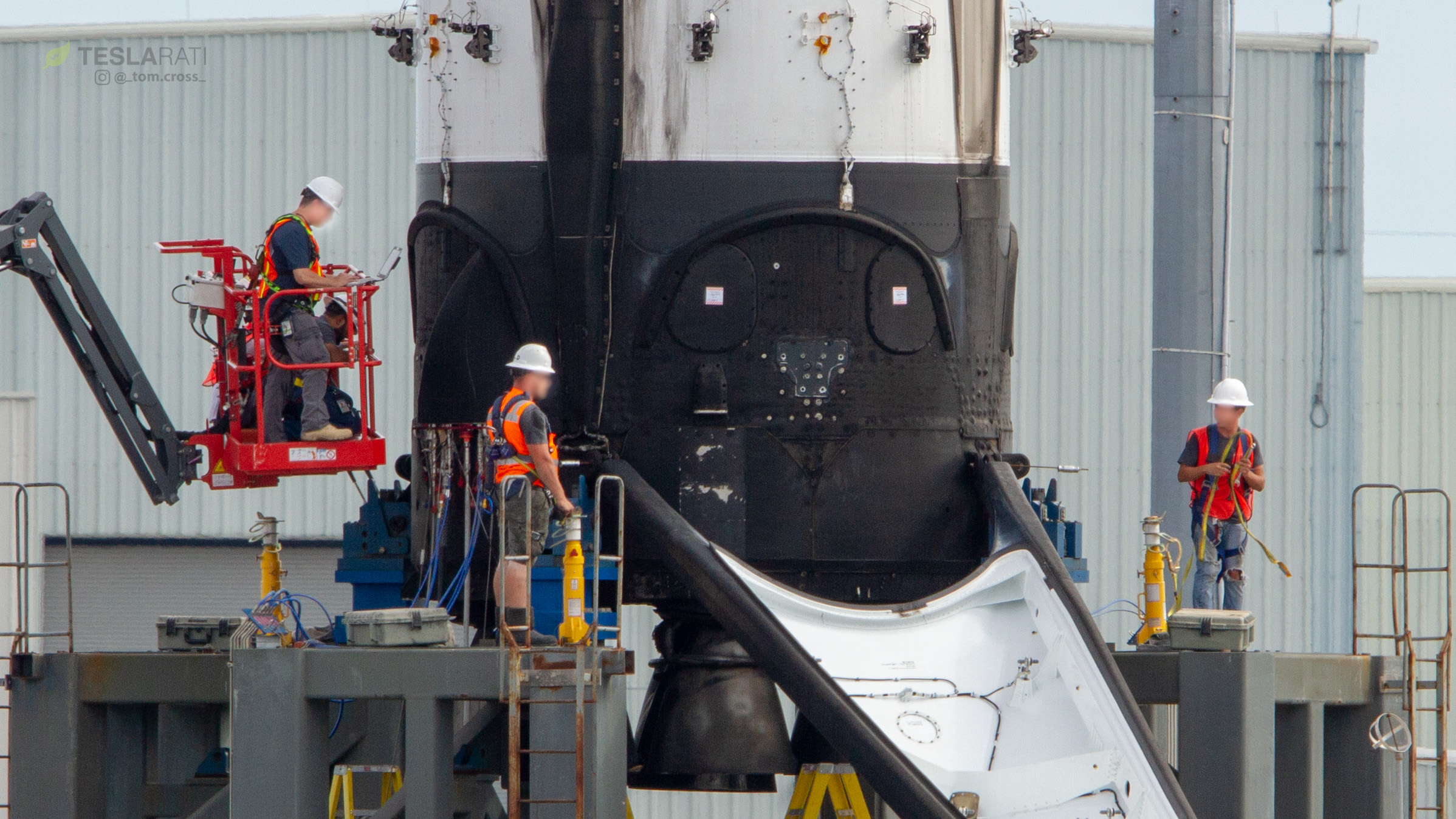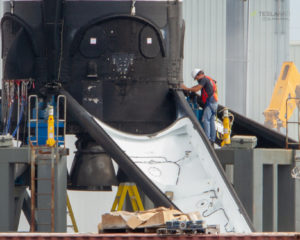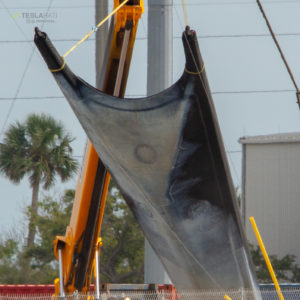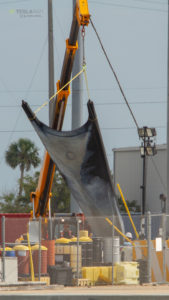

News
SpaceX team spotted removing Block 5 landing legs prior to teardown analysis
Teslarati photographer Tom Cross has captured SpaceX technicians removing the landing legs from the first Falcon 9 Block 5 booster, signaling that the end of recovery operations are near.
Of note, it appears that SpaceX chose to conduct this recovery much like previous ones by removing the rocket’s legs instead of retracting them, a feature of the Block 5 upgrade prominently noted by CEO Elon Musk and other company officials. A brief time-lapse shows workers carefully removing the legs in a well-worn ballet of heavy machinery, skirting around the massive rocket with expertise developed over the better part of two years of sea and land recoveries of Falcon 9 and Falcon Heavy boosters.
There are a number of possible reasons for SpaceX choosing to remove B1046’s landing legs the ‘old-fashioned’ way, most relating to the fact that this particular booster is a critical pathfinder for the entire future of Falcon 9 Block 5. Musk described this attitude in a lengthy and detailed prelaunch briefing:
We are going to be very rigorous in taking this rocket apart and confirming our design assumptions to be confident that it is indeed able to be reused without being taken apart. Ironically, we need to take it apart to confirm that it does not need to be taken apart.
Both COO Shotwell and Musk have briefly discussed the new functionality of the upgraded legs in the past few weeks, indicating that they are capable of being rapidly and repeatedly stowed without being removed from the rocket, whereas all past booster reuse has required the slow removable and equally slow reattachment of landing legs, assuming Block 3 and 4 boosters even reuse their same landing legs. At a minimum, Musk’s above comment already makes it clear that SpaceX has no plans to reuse this booster immediately, instead conducting an extremely thorough teardown analysis to verify that wear and tear from high-speed atmospheric reentry is within an acceptable range.

SpaceX technicians busy themselves removing Falcon 9 Block 5’s massive recovery hardware. (Tom Cross)
Equally plausible, choosing to remove B1046’s landing legs instead of testing the new retraction mechanisms may better preserve the leg hardware in its post-landing state, providing engineers and technicians cleaner and more representative data. One final obvious possibility is that the process of flight-testing new Block 5 leg hardware caused damage or led to some off-nominal telemetry and other visible faults, thus preventing them from retracting.
Because the next Block 5 booster (B1047) is likely nearing its own debut after a thorough round of testing in Texas, captured by an aerial photographer, SpaceX may be pushing hard to complete its post-landing analysis of B1046 as quickly as possible to make way for the imminent launches of several new boosters. If the company hopes to maintain its impressive 2018 flight rate of one launch every two weeks throughout the rest of the year, they will need to refly Block 5 boosters at least 10 times – the last flight-proven commercial Block 4 launch (CRS-15) is currently scheduled for early July, leaving roughly half of all 2018’s upcoming launches manifested on Block 5 Falcon 9/Heavy rockets. Falcon Heavy’s second launch has in fact been pushed back by several months per The Planetary Society, indicating that the construction of the first Block 5 center booster has taken a back seat to the more pressing concerns of Falcon 9 Block 5 boosters, upper stages, and fairings needed to avoid additional customer launch delays.

B1046’s final landing leg is removed and carried off with a forklift, presumably for teardown analysis at a SpaceX facility. (Tom Cross)
Regardless, the first successful and nearly-complete recovery of a Falcon 9 Block 5 booster marks a huge milestone for SpaceX. So long as the imminent teardown analysis does not reveal anything especially unexpected, the rocket company is quickly closing in on true rapid reuse with Octagrabber/Roomba’s steady routinization of robotic rocket saving, yet another intact fairing half recovery, and the good condition of B1046 after a relatively hot reentry and landing.
- Just boopin’ an orbital-class rocket with a huge metal component, NBD. (Tom Cross)
- (Tom Cross)
- A toasty Block 5 landing leg shows off a new patina for SpaceX’s upgraded thermal protection material.
- (Tom Cross)
Follow us for live updates, behind-the-scenes sneak peeks, and a sea of beautiful photos from our East and West coast photographers.
Teslarati – Instagram – Twitter
Tom Cross – Twitter
Pauline Acalin – Twitter
Eric Ralph – Twitter

Elon Musk
Elon Musk’s X will start using a Tesla-like software update strategy
The initiative seems designed to accelerate updates to the social media platform, while maintaining maximum transparency.

Elon Musk’s social media platform X will adopt a Tesla-esque approach to software updates for its algorithm.
The initiative seems designed to accelerate updates to the social media platform, while maintaining maximum transparency.
X’s updates to its updates
As per Musk in a post on X, the social media company will be making a new algorithm to determine what organic and advertising posts are recommended to users. These updates would then be repeated every four weeks.
“We will make the new 𝕏 algorithm, including all code used to determine what organic and advertising posts are recommended to users, open source in 7 days. This will be repeated every 4 weeks, with comprehensive developer notes, to help you understand what changed,” Musk wrote in his post.
The initiative somewhat mirrors Tesla’s over-the-air update model, where vehicle software is regularly refined and pushed to users with detailed release notes. This should allow users to better understand the details of X’s every update and foster a healthy feedback loop for the social media platform.
xAI and X
X, formerly Twitter, has been acquired by Elon Musk’s artificial intelligence startup, xAI last year. Since then, xAI has seen a rapid rise in valuation. Following the company’s the company’s upsized $20 billion Series E funding round, estimates now suggest that xAI is worth tens about $230 to $235 billion. That’s several times larger than Tesla when Elon Musk received his controversial 2018 CEO Performance Award.
As per xAI, the Series E funding round attracted a diverse group of investors, including Valor Equity Partners, Stepstone Group, Fidelity Management & Research Company, Qatar Investment Authority, MGX, and Baron Capital Group, among others. Strategic partners NVIDIA and Cisco Investments also continued support for building the world’s largest GPU clusters.
News
Tesla FSD Supervised wins MotorTrend’s Best Driver Assistance Award
The decision marks a notable reversal for the publication from prior years, with judges citing major real-world improvements that pushed Tesla’s latest FSD software ahead of every competing ADAS system.

Tesla’s Full Self-Driving (Supervised) system has been named the best driver-assistance technology on the market, earning top honors at the 2026 MotorTrend Best Tech Awards.
The decision marks a notable reversal for the publication from prior years, with judges citing major real-world improvements that pushed Tesla’s latest FSD software ahead of every competing ADAS system. And it wasn’t even close.
MotorTrend reverses course
MotorTrend awarded Tesla FSD (Supervised) its 2026 Best Tech Driver Assistance title after extensive testing of the latest v14 software. The publication acknowledged that it had previously criticized earlier versions of FSD for erratic behavior and near-miss incidents, ultimately favoring rivals such as GM’s Super Cruise in earlier evaluations.
According to MotorTrend, the newest iteration of FSD resolved many of those shortcomings. Testers said v14 showed far smoother behavior in complex urban scenarios, including unprotected left turns, traffic circles, emergency vehicles, and dense city streets. While the system still requires constant driver supervision, judges concluded that no other advanced driver-assistance system currently matches its breadth of capability.
Unlike rival systems that rely on combinations of cameras, radar, lidar, and mapped highways, Tesla’s FSD operates using a camera-only approach and is capable of driving on city streets, rural roads, and freeways. MotorTrend stated that pure utility, the ability to handle nearly all road types, ultimately separated FSD from competitors like Ford BlueCruise, GM Super Cruise, and BMW’s Highway Assistant.
High cost and high capability
MotorTrend also addressed FSD’s pricing, which remains significantly higher than rival systems. Tesla currently charges $8,000 for a one-time purchase or $99 per month for a subscription, compared with far lower upfront and subscription costs from other automakers. The publication noted that the premium is justified given FSD’s unmatched scope and continuous software evolution.
Safety remained a central focus of the evaluation. While testers reported collision-free operation over thousands of miles, they noted ongoing concerns around FSD’s configurable driving modes, including options that allow aggressive driving and speeds beyond posted limits. MotorTrend emphasized that, like all Level 2 systems, FSD still depends on a fully attentive human driver at all times.
Despite those caveats, the publication concluded that Tesla’s rapid software progress fundamentally reshaped the competitive landscape. For drivers seeking the most capable hands-on driver-assistance system available today, MotorTrend concluded Tesla FSD (Supervised) now stands alone at the top.
News
Elon Musk’s Grokipedia surges to 5.6M articles, almost 79% of English Wikipedia
The explosive growth marks a major milestone for the AI-powered online encyclopedia, which was launched by Elon Musk’s xAI just months ago.

Elon Musk’s Grokipedia has grown to an impressive 5,615,201 articles as of today, closing in on 79% of the English Wikipedia’s current total of 7,119,376 articles.
The explosive growth marks a major milestone for the AI-powered online encyclopedia, which was launched by Elon Musk’s xAI just months ago. Needless to say, it would only be a matter of time before Grokipedia exceeds English Wikipedia in sheer volume.
Grokipedia’s rapid growth
xAI’s vision for Grokipedia emphasizes neutrality, while Grok’s reasoning capabilities allow for fast drafting and fact-checking. When Elon Musk announced the initiative in late September 2025, he noted that Grokipedia would be an improvement to Wikipedia because it would be designed to avoid bias.
At the time, Musk noted that Grokipedia “is a necessary step towards the xAI goal of understanding the Universe.”
Grokipedia was launched in late October, and while xAI was careful to list it only as Version 0.1 at the time, the online encyclopedia immediately earned praise. Wikipedia co-founder Larry Sanger highlighted the project’s innovative approach, noting how it leverages AI to fill knowledge gaps and enable rapid updates. Netizens also observed how Grokipedia tends to present articles in a more objective manner compared to Wikipedia, which is edited by humans.
Elon Musk’s ambitious plans
With 5,615,201 total articles, Grokipedia has now grown to almost 79% of English Wikipedia’s article base. This is incredibly quick, though Grokipedia remains text-only for now. xAI, for its part, has now updated the online encyclopedia’s iteration to v0.2.
Elon Musk has shared bold ideas for Grokipedia, including sending a record of the entire knowledge base to space as part of xAI’s mission to preserve and expand human understanding. At some point, Musk stated that Grokipedia will be renamed to Encyclopedia Galactica, and it will be sent to the cosmos.
“When Grokipedia is good enough (long way to go), we will change the name to Encyclopedia Galactica. It will be an open source distillation of all knowledge, including audio, images and video. Join xAI to help build the sci-fi version of the Library of Alexandria!” Musk wrote, adding in a later post that “Copies will be etched in stone and sent to the Moon, Mars and beyond. This time, it will not be lost.”












